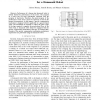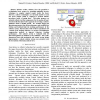7 search results - page 1 / 2 » Design and evaluation of a gravity compensation mechanism fo... |
IROS
2007
IEEE
13 years 11 months ago
2007
IEEE
— Performance of a human size humanoid robot is strictly limited by performance of the motor. The progress of a motor has not been remarkable compared with the progress of electr...
ICRA
2008
IEEE
13 years 11 months ago
2008
IEEE
— This paper describes the design of a gravity balanced spatial orthosis. Previous works introduced planar mechanisms only and neglected friction. They relied on counterweight or...
ROBIO
2006
IEEE
13 years 10 months ago
2006
IEEE
- Suddenly occurring collisions or unintentional motions represent a high safety risk in robotics and must be prevented. Especially for humanoid robots, the influence of disturbanc...
ICRA
2010
IEEE
13 years 2 months ago
2010
IEEE
Robotic cardiac catheters have the potential to revolutionize heart surgery by extending minimally invasive techniques to complex surgical repairs inside the heart. However, cathet...
ISER
2004
Springer
13 years 10 months ago
2004
Springer
This paper presents the design of a selective-actuation flexure parallel mechanism that can provide three independent translational motions. The mechanism can be used as an ultra p...



